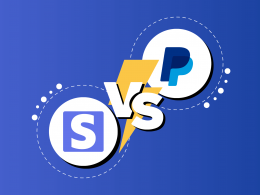Effectively handling cash flow stands out as a significant challenge for small businesses. Are you a new business owner or freelancer struggling to write your first invoice? Are you stressed about invoicing your goods or services and collecting your first payment? You’re not alone; many of us have been there.
Invoice writing can be overwhelming, especially if it’s your first time. A proper invoicing process is crucial for managing payments, taxes, and customer accounts. Knowing how to write an invoice is vital for any business owner.
In this article, we’ll guide you through the process of writing a simple and effective invoice. We will delve into the essential components of an invoice, explore different types, and provide valuable tips on how to craft an effective one. Whether you’re a new business owner or freelancer, mastering the art of invoice writing is essential for the success of your business.
Key takeaways
- Invoices are key to formal payment requests, ensuring transaction transparency and maintaining a robust cash flow.
- Various invoice types, from sales to tax invoices, cater to distinct business requirements, ensuring clarity and efficiency in financial dealings.
- Crucial components like invoice numbers, party identification, dates, item descriptions, and payment details contribute to a well-structured and transparent invoicing process.
- Utilizing tools like Synder streamlines invoicing while crafting professional email invoices with clarity, promoting seamless communication.
- Emphasizing practices like clear invoicing, precise payment terms, multiple payment options, and personal client relationships fosters professionalism and increases the likelihood of prompt payments.
Contents:
1. What exactly is an invoice?
2. Different types of invoices
3. Anatomy of an invoice: What is the format of writing an invoice?
4. How to create an invoice using Synder
5. How to write an email invoice
7. Invoicing best practices to get paid on time
8. Payment terms: The essential considerations
9. What to do when customers don’t pay an invoice
10. Invoicing & reconciliation
11. How to write an invoice: Recap
12. How to write an invoice: FAQs
What exactly is an invoice?
An invoice is a formal document requesting payment for goods or services provided. It outlines the transaction details, including the products or services rendered, quantities, prices, and payment terms.
Ultimately, an invoice tells the recipient when, how, and how much they must pay. Consider it a financial handshake between you and your client, a record that ensures transparency and helps maintain a healthy cash flow.
This emphasizes the importance of having a well-organized invoice and clearly defined payment terms to ensure prompt payment.
Different types of invoices
Various invoices exist, and many options can be overwhelming without a clear understanding. The invoices you’ll send depend on your industry, the nature of your work, and your preferred payment frequency.

Some common types include:
- Sales/purchase invoice,
- Tax invoice,
- Pro forma invoice,
- Interim invoice,
- Final invoice,
- Recurring invoice,
- Past due invoice,
- Credit invoice,
- Commercial invoice.
Now, let’s break down each type of invoice for clarity:
1. Sales/purchase invoice
Purpose: Records the sale of goods or services.
Use: Sent to customers for payment or received from suppliers.
2. Tax invoice
Purpose: Includes details required for tax purposes.
Use: Essential for businesses that need to report taxable income and claim tax credits.
3. Pro forma invoice
Purpose: An estimated invoice sent in advance of the actual transaction.
Use: Used for quoting prices, outlining terms, and ensuring mutual understanding before a deal is finalized.
4. Interim invoice
Purpose: Issued during ongoing projects to request partial payment.
Use: Useful for large projects with extended timelines, allowing for continuous cash flow.
5. Final invoice
Purpose: Marks the completion of a project or the delivery of goods.
Use: Sent once all products or services have been provided, indicating the final amount due.
6. Recurring invoice
Purpose: Generated at regular intervals for subscription-based services.
Use: Common for businesses with recurring revenue models, ensuring consistent payments.
7. Past due invoice
Purpose: Sent to remind customers of overdue payments.
Use: Helps address late payments and maintain a clear payment schedule.
8. Credit invoice
Purpose: Reflects a reduced amount owed due to returns or overpayments.
Use: Issued when there’s a need to adjust the original invoice amount.
9. Commercial invoice
Purpose: Essential for international trade, providing details for customs clearance.
Use: Required when shipping goods across borders, serving as a declaration of the products and their value.
Understanding these distinctions ensures you use the right format for your business needs. Each type has its purpose, whether it’s for advance payments, ongoing services, or corrections to previous invoices.
Anatomy of an invoice: What is the format of writing an invoice?
1. Invoice number: Do all invoices need a reference number?
Assign a unique identifier to each invoice. Typically, it combines letters and numbers sequentially or based on a specific coding system.
This number is essential for tracking purposes and aids in organizing your financial records. It also serves as a reference point in communications with your clients.
2. Identify the parties: Your company details and client information
Your contact information
Start your invoice by prominently featuring your contact details. Include your
- business name,
- logo,
- address,
- phone number,
- and email.
This establishes a clear line of communication and allows your clients to reach out easily.
Customer information
Provide your client’s details accurately. Include their name, address, and any relevant contact information. Ensuring the accuracy of this information is crucial for a smooth invoicing process.
3. Date of invoice
Clearly state the date when the invoice is issued. Usually placed at the top of the invoice, stating the day, month, and year. This helps you and your client track the transaction’s timeline and sets the groundwork for establishing payment terms.
4. Date of supply
The ‘supply date’ is when the goods were purchased, or the service was carried out. Essential for tracking the timeline of the transaction.
5. Payment due date
Specify the deadline by which payment is expected. This clarifies your clients and helps you manage your cash flow effectively. Be explicit about any late fees or early payment discounts associated with the due date.
6. Describe what’s being purchased
Line items
Break down the invoice into line items, listing each product or service provided. Each service or item should be included on a separate line, so it’s easy to understand.
Description of services
For each line item, provide a detailed description to ensure your client understands what they are being billed for. This transparency builds trust and minimizes the risk of disputes.
Detailed cost breakdown
When providing multiple items or services, ensure that each item is clearly listed along with its corresponding individual amount.
7. Total amount due
Clearly state the total amount owed by the client. Sum up all the line items, considering any applicable taxes or discounts. This figure serves as the focal point for the payment transaction.
8. Give the payment details
Specify the preferred method for invoice payment and include pertinent details such as your sort code and account number for BACS transfer.
9. Terms of payment
Payment terms specify the timeframe and method by which the customer is expected to make payment. For instance, you may stipulate, ‘Payment is due within 14 days from the invoice date via BACS transfer.’ Any specific terms, discounts, or penalties for early or late payments.
10. Any notes
If there are specific instructions, terms, or additional information relevant to the invoice, include it in the notes section. This could be a personalized thank-you message, additional payment details, or any other relevant communication.
A well-crafted invoice is a fundamental tool for any business aiming for financial success. By incorporating these essential elements – from contact information to detailed line items – you create a document that ensures timely payments and reflects positively on your professionalism.
Note: Clarity is key; the more transparent and detailed your invoice is, the smoother your financial transactions will be. Implement these practices in your invoicing process to foster trust with your clients and contribute to the overall success of your business.
How to create an invoice using Synder
Whether you utilize Square or Stripe payment platforms and rely on QuickBooks Online for your accounting needs, Synder’s invoicing feature is a key element in simplifying the invoicing process. Many customers face challenges in promptly settling invoices, and the complexity of this procedure often contributes to delays.
Synder’s invoicing software effortlessly addresses this issue, streamlining the creation and delivery of user-friendly invoices for credit card payments. Furthermore, it seamlessly integrates with QuickBooks Online, automatically managing both invoices and payments. With Synder, you can effortlessly generate, send, schedule, and oversee recurring invoices, similar to QuickBooks’ recurring invoice feature, all conveniently accessible through the management tab. This powerful invoicing tool is designed to save you time and enhance the efficiency of your financial processes.
Note: Moreover, using the Synder Smart Rules feature & its ready-made templates, you can automatically send a customized email or text follow-up to customers, reminding them to pay their overdue invoice—so you can stop chasing payments.
How to write an email invoice
Crafting an effective email invoice is essential for seamless business transactions.

1. Subject line clarity
Start your email invoice by creating a clear and concise subject line that indicates the purpose of the email and the presence of an invoice.
2. Greeting and introduction
In the body of the email, begin with a polite greeting and a brief introduction, setting a positive tone for the transaction.
3. Description
Provide a comprehensive yet succinct description of the products or services rendered, ensuring clarity for the recipient.
4. Key information inclusion
Clearly state essential details such as the invoice number, date of issuance, and the payment due date prominently within the email.
5. Document attachment
Attach the invoice document in a widely compatible format, such as PDF, ensuring easy access and viewing for the recipient.
6. Total amount and breakdown
Specify the total amount due, including any applicable taxes or additional fees, providing a transparent breakdown of the charges.
7. Professional closing
End the email with a professional closing, expressing gratitude for the business and providing contact information for any inquiries.
By following these steps, you can streamline the process of writing and sending an email invoice, promoting professionalism and clarity in your business communication.
Sample email invoice
Feel free to take a look at the example below for a practical demonstration of crafting a professional email invoice following the outlined steps.
Subject Line: Invoice for Graphic Design Services – Invoice #GD12345
Dear [Client’s Name],
I trust this email finds you well. Working with you on your recent graphic design project has been our pleasure. To facilitate a smooth transaction, we are pleased to present the invoice (#GD12345) for the services rendered.
We provided graphic design services for [Project Name], including creating custom graphics, layout design, and revisions as per your feedback.
Invoice Number: GD12345
Date of Issuance: February 15, 2024
Due Date: March 1, 2024
Attached to this email is the detailed invoice in PDF format for your convenience. Please feel free to review, and don’t hesitate to reach out if you have any questions or require further clarification.
Subtotal: $XXXX.XX
Tax (8%): $XXX.XX
Total Amount Due: $XXXX.XX
We appreciate your prompt attention to this matter. If you have any inquiries or need assistance, please feel free to contact us at [Your Contact Information]. Thank you for choosing our services; we look forward to your continued partnership.
Best regards,
[Your Full Name] [Your Position] [Your Company Name] [Your Contact Information]How to send an invoice
Ensuring your customers receive invoices involves exploring various options, as no universal method is applicable to all businesses. What proves effective for one enterprise may not be suitable for another, necessitating consideration of your customer base and determining the most efficient and secure delivery method for your invoices.
When deciding between email, traditional mail, or online software for sending invoices, each option has its own advantages and disadvantages.
This section will examine these 3 common methods, evaluating their merits and drawbacks to help you make an informed choice tailored to your business needs.

1. Traditional mail
Sending invoices through post has been a time-tested method, providing a physical copy that serves as a tangible transaction record. This traditional approach offers a sense of formality and reliability, particularly in industries where physical documentation holds significance.
2. Digital swiftness with email
Nowadays, email has emerged as a swift and widely adopted method for delivering invoices. This approach expedites the invoicing cycle and aligns with modern communication practices. Email invoices are easily trackable, fostering efficient record-keeping and reducing environmental impact by minimizing paper usage.
3. Streamlining with online invoicing software
Online invoicing software takes invoicing to the next level, providing businesses with a professional and convenient solution. These platforms enable the creation, customizing, and tracking of invoices in a centralized system. By leveraging such software, businesses can enhance organization, reduce errors, and ensure a seamless invoicing experience for both the sender and the recipient.
Invoicing best practices to get paid on time
Adopting effective invoicing practices enhances professionalism and significantly contributes to ensuring timely payments. Here are key invoicing best practices to streamline your billing process and encourage timely settlements.

1. Craft clear and detailed invoices
Craft clear and detailed invoices that leave no room for ambiguity. Include a breakdown of products or services, quantities, rates, and any applicable taxes. The more transparent your invoice, the easier it is for clients to understand and process.
2. Set precise payment terms
Clearly define payment terms, specifying the due date and any applicable late fees or early payment discounts. Whether it’s “Net 30” or another arrangement, precise terms set expectations and promote timely payments.
3. Utilize professional invoice templates
Invest in professional invoice templates that align with your brand. A polished and well-designed invoice enhances your credibility and reinforces the professionalism of your business.
4. Employ digital invoicing software
Leverage digital invoicing software for efficiency and organization. These tools streamline the invoicing process, automate reminders, and provide a centralized platform for tracking payments.
5. Provide multiple payment options
Offer flexibility by accepting various forms of payment, such as credit cards, bank transfers, or digital wallets. Providing multiple options accommodates diverse client preferences and expedites the payment process.
6. Send invoices promptly
Send out invoices promptly after delivering products or completing services. Timely invoicing sets the tone for a proactive and organized approach to financial transactions.
7. Follow up on overdue payments
Implement a consistent follow-up system for overdue payments. Send polite yet firm reminders to clients who have missed the payment deadline to ensure they are aware of the outstanding invoice.
8. Implement a late payment policy
Clearly communicate your late payment policy, including any penalties or interest charges. Having a well-defined policy discourages late payments and reinforces the importance of adhering to agreed-upon terms.
9. Build personal relationships
Cultivate personal relationships with clients. A strong client-business relationship fosters a sense of accountability and encourages timely payments, as clients are more likely to prioritize businesses, they have a positive rapport.
10. Regularly review and update invoicing practices
Periodically review and update your invoicing practices to adapt to changing business needs and industry standards. Staying current ensures your processes remain efficient and effective.
By incorporating these invoicing best practices into your business operations, you establish a reliable and transparent financial framework and increase the likelihood of receiving payments on time, contributing to the overall success of your enterprise.
Explore our insightful guide on invoicing to steer clear of 8 common issues that could impact your cash flow: Invoicing: Avoid These 8 Issues for a Healthy Cash Flow.
Payment terms: The essential considerations
Establishing well-defined payment terms is a critical component that directly influences your business’s financial health and efficiency. This section aims to provide comprehensive insights into the key factors businesses should consider when formulating their invoice payment terms.

1. Clarity in due dates
Clearly specify the payment due date, for instance, indicating a timeframe such as “14 days from the invoice date.” This ensures both parties have a mutual understanding of the expected payment timeline.
2. Accepted forms of payment
Explicitly outline the forms of payment you accept, whether it be credit cards, bank transfers, or other methods. This information facilitates smoother transactions and avoids potential misunderstandings.
3. Currency details for international transactions
If your business operates internationally, make sure to specify the currency you deal in. This transparency helps clients understand the financial terms, especially when working across different countries with varying currencies.
4. Late payment penalties
Clearly communicate any late payment penalties that may apply, promoting accountability and providing an additional incentive for clients to adhere to the agreed-upon payment schedule.
5. Returns policy
If your business has a returns policy, include a brief overview of its terms in the invoice. This ensures clients know the conditions and procedures for returning products or services, clarifying potential post-purchase scenarios.
6. Warranty terms
For goods or services under warranty, include concise details about the warranty terms. This clarifies the duration and conditions under which clients can expect warranty coverage, contributing to a transparent and trustworthy business relationship.
What to do when customers don’t pay an invoice
Dealing with customers who haven’t paid an invoice can be challenging, but addressing it promptly and professionally is essential. This section will provide a step-by-step guide on what to do when customers don’t pay an invoice.
1. Send a friendly reminder
Initiate with a polite and friendly reminder, as the oversight might be unintentional.
2. Follow up with clear communication
If the initial reminder doesn’t yield results, send a more assertive but professional communication clearly stating the outstanding amount and due date.
3. Phone call or personal contact
Consider making a phone call or reaching out personally to uncover any customer issues.
4. Offer flexible payment options
Be open to discussing flexible payment options, such as a payment plan or extended deadline, in cases of financial difficulties.
5. Issue a late payment notice
If an amicable resolution fails, send a formal late payment notice outlining consequences, including potential legal actions or credit reporting.
6. Consider legal action
Consult legal counsel to explore legal actions like small claims court or hiring a collections agency, depending on the amount owed.
7. Cease further services
Temporarily halt services until payment is resolved, motivating the customer to address the issue promptly.
Remember to document all communications and efforts to resolve the issue. Maintaining a thorough record will be beneficial if legal action becomes necessary. While it’s crucial to be firm in seeking payment, maintaining professionalism throughout the process is key to preserving relationships and your business reputation.
Invoicing & reconciliation
Invoicing and reconciliation are integral components of financial management that ensure accuracy and transparency in business transactions.
Invoicing
Invoicing serves as a formal record of the products or services provided, detailing the terms and conditions for payment. It is a critical communication tool between businesses and clients, facilitating a clear understanding of financial obligations.
Explore our article Online Invoicing for Small Businesses: Handling Invoice Management With Small Business Accounting Software for a comprehensive understanding of streamlined financial management.
Reconciliation
On the other hand, reconciliation involves the thorough process of comparing financial records to identify and rectify discrepancies, ensuring that the data in the company’s internal statements aligns with external statements, such as bank statements. This practice is crucial for maintaining financial integrity, detecting errors, and preventing fraudulent activities.
Invoicing and reconciliation contribute to the overall financial health of a business by fostering accountability, minimizing errors, and providing a solid foundation for informed decision-making.
Automated reconciliation: Sync your data with Synder
Automated reconciliation, exemplified by third-party apps like Synder, utilizes technology to streamline the bank reconciliation process by proactively verifying all transactions in your accounting company, let’s say QuickBooks Online, through Synder. Curious about how it works? Let’s explore.
Imagine your Shopify store is linked to QuickBooks Online, and Synder replicates your money flow within the QuickBooks environment. When customers make purchases, transactions first go through your payment processor, and subsequently, the payment processor transfers the funds to your designated bank account (‘Checking’) in QuickBooks.
Synder efficiently syncs both sales and expense transactions to the ‘Clearing’ account in QuickBooks, labeled as the ‘Shopify Bank Account.’ When the payout occurs in the actual bank, the app synchronizes and generates a transfer from the ‘Clearing’ account to your ‘Checking’ account, accurately reflecting the actual money flow. You can simplify the bank reconciliation process in just a few clicks in the ‘Banking’ section, where the information automatically synced by Synder seamlessly aligns with your real money transfers.
Take advantage of the opportunity to optimize your business processes and explore Synder features with a free trial. To gain more insights and tips, book your seat on the informative Weekly Public Demo offered by Synder. Elevate your financial management with Synder – where simplicity meets effective financial operations.
How to write an invoice: Recap
Invoicing is fundamental to business operations, influencing cash flow, transparency, and client relationships. From understanding the types of invoices to mastering the anatomy of an invoice, adopting best practices, and handling unpaid invoices professionally, a well-executed invoicing process is crucial for the success of any business.
Integrating invoicing tools like Synder and the application of strategies discussed in this article will streamline your invoicing process and contribute to a more efficient and prosperous financial framework for your enterprise.
Related reading: 5 Tips for Invoicing – Add Value without Adding Additional Time
Share your opinion
Writing invoices? We want to know how it’s going for you! Share your experiences – the wins, the challenges, and any clever tips you’ve picked up along the way. Your insights can be a game-changer for someone else. Drop a comment, and let’s build a community where we learn from each other’s invoicing experience!
How to write an invoice: FAQs
1. Can I write invoices by hand?
Certainly, writing invoices by hand is acceptable. However, for a more streamlined and professional approach, many businesses opt for digital invoicing tools or templates, which offer efficiency and enhanced record-keeping.
2. Why are there 3 copies of invoices?
The three copies of invoices serve distinct purposes. The first copy is provided to the customer for their records. You retain the second copy for internal record-keeping; the third copy is often designated for your accountant or tax purposes. This tripartite system ensures comprehensive documentation and smooth financial management.
3. What is a VAT invoice?
A VAT invoice is a document that includes details about VAT for goods or services provided. This type of invoice is essential for businesses involved in taxable transactions. It outlines the VAT applied to the transaction, providing clarity for both the seller and the buyer. Properly managing VAT invoices is crucial for tax reporting and compliance.

.png)




